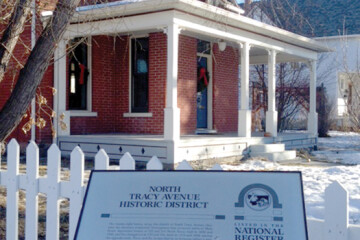Parkitecture: The History of Bogert Park
June brings the opening salvo of tourist season, during which we welcome new visitors from around the world as well as locals returning for their fix of fresh air and mountain views. From hiking the “M” to dancing on Main Street, our community takes advantage of long summer nights to participate in activities and explore amenities unique to Bozeman. A favorite center of activity is Bogert Park, on South Church Avenue.
Agriculture, education and transportation historically drove Bozeman’s economy, however, proximity to Yellowstone National Park (YNP) and related tourism industries established an early foothold as a business opportunity in the community. Initially most visitors arrived via the railroad and traveled through Bozeman to the park on guided stagecoach tours.
Poor roads hampered automobile travel to YNP after the turn of the 20th century. The Yellowstone Trail Association, founded in 1912, coordinated committees of local businessmen who saw the economic potential of having an all-weather road to Yellowstone routed through their community. The committees identified the best roads in their area and lobbied the local government for the necessary funds to improve driving surfaces. The committees marked the Yellowstone Trail route with stones painted yellow, or painted with the official yellow circle and arrow of the organization. Bozeman was a Yellowstone Trail community, and the identifying yellow circular marking is visible on the Story Block, at 33-39 East Main Street.
As visitors to YNP increasingly relied upon automobile transportation, related services evolved to provide for visitor’s needs in Bozeman. An area on South Church Avenue referred to as “Bogert’s Grove,” in honor of the land’s early owner and first mayor of Bozeman John V. Bogert, had long been a favorite overnight camping location during community events like the Bozeman Roundup. The area became a “Tourist Park” after the City purchased the 6.8 acre parcel from Bogert’s heirs in the 1920’s.
Motorists used the Bogert Tourist Park to overnight camp, often taking advantage of new innovations by automobile manufacturers like Ford, which sold Model-T accessories specifically made to improve the car-camping experience. Visitors enjoyed proximity to Bozeman Creek, the Main Street commercial district and the shade from large cottonwood trees around the park.
The City improved the park in 1938 with the addition of a concrete swimming pool and dressing rooms. The structure was designed by local architect Fred Willson, whose lengthy list of other notable public buildings includes the Gallatin County Courthouse, Emerson School, Willson School, and the Armory. Though extensively remodeled in the 1970’s, Bogert Pool remains Bozeman’s only public outdoor pool and a local favorite. The original Willson drawings for Bogert Pool are on file in Special Collections of the Renne Library on the Montana State University campus in Bozeman.
In 1939 the City turned again to Willson for design of an open-air shelter to provide space for public performances by the City Band. The band shell’s design relied heavily on the log-construction technique popularized by the National Park Service during this time period, subtly reinforcing Bozeman’s economic connection to YNP. These drawings can also be found at MSU’s Special Collections.
Frequently referred to as “Parkitecture,” the architectural style stemmed from National Park Service policy to create buildings of rustic design which reflected the natural features of the area. The style spread during the 1930’s, when the federal government implemented Parkitecture designs across the United States through NPS direction of Civilian Conservation Corps projects in state parks.
The juxtaposition of architectural styles seen in the Art Deco Armory, on West Mendenhall Street, and the Streamline Moderne Willson School, on West Main Street, against the Bogert band shell’s Parkitecture style underscores the architectural range of Fred Willson’s design skills.
The Bogert band shell is a classic example of Depression Era buildings of the Parkitecture style, with both stacked log and log veneer construction. Modifications in the 1990’s included a coat of paint, new electrical connections, and a slight enlargement of the stage. The Bogert band shell recently underwent extensive rehabilitation in 2009, for which the Bozeman Historic Preservation Advisory Board awarded the City of Bozeman an Excellence in Historic Preservation Award.
Bogert Park has grown to include tennis courts and a covered pavilion, and continues to be a gathering place where locals and visitors spread blankets and lawn chairs to enjoy live music from the band shell, swim in the pool, relax near the creek and sample the wares at the Bogert Farmer’s Market, held every Tuesday during summer months. Though car-camping has been discontinued, a detour to Bogert Park to participate in a community event is well worth any visitor’s time.
 Courtney Kramer is a proud graduate of MSU’s History Department and serves as the City of Bozeman’s Historic Preservation Officer. She may be contacted at the City Planning Office, 406-582-2260 or via email at ckramer@bozeman.net. More information about Bozeman’s historic districts is available at www.preservebozeman.org
Courtney Kramer is a proud graduate of MSU’s History Department and serves as the City of Bozeman’s Historic Preservation Officer. She may be contacted at the City Planning Office, 406-582-2260 or via email at ckramer@bozeman.net. More information about Bozeman’s historic districts is available at www.preservebozeman.org


